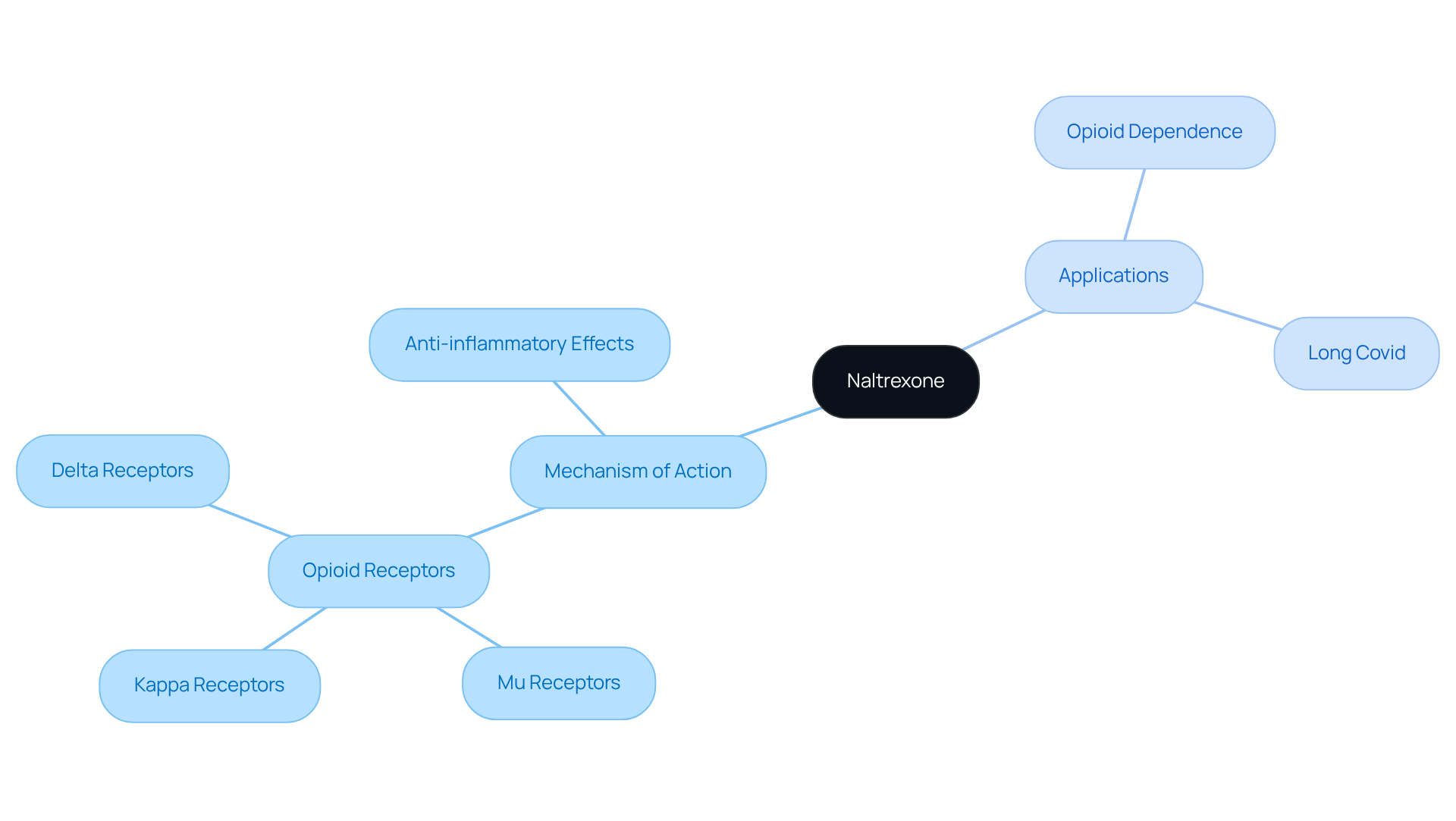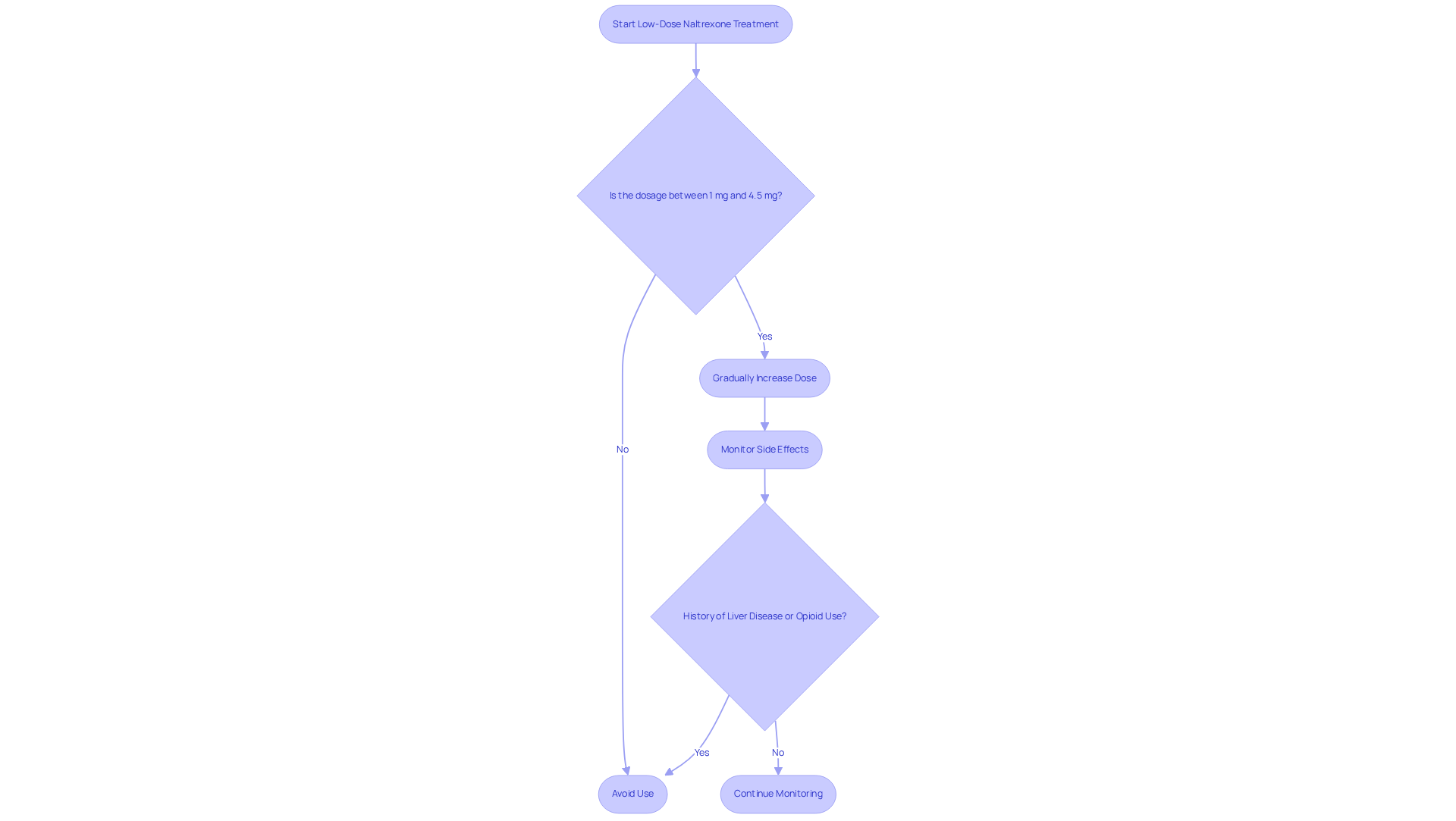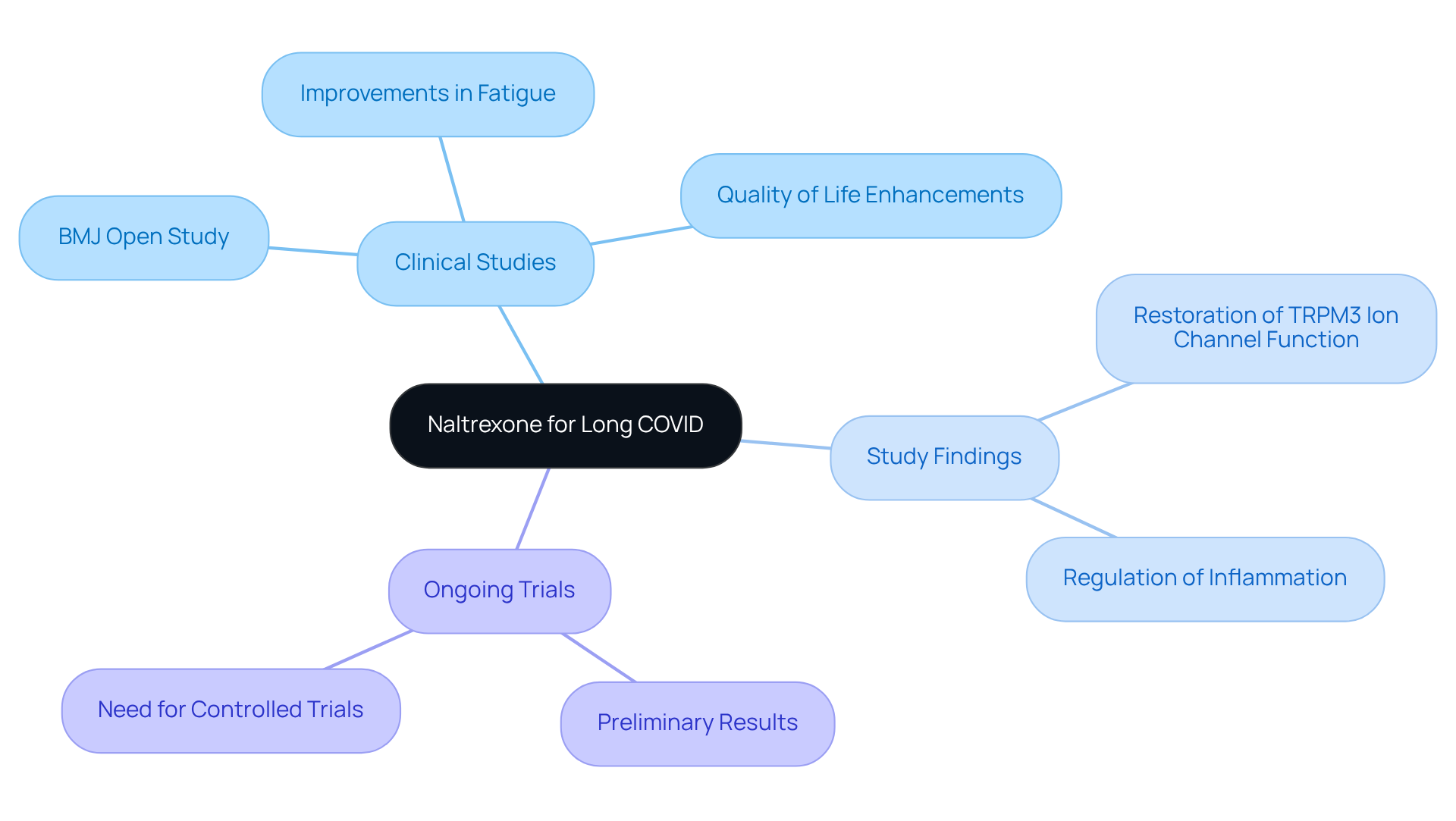Naltrexone for Long COVID: Understanding Its Mechanism and Dosage
Overview
Naltrexone, particularly in low doses (LDN), demonstrates potential for alleviating long COVID symptoms. By harnessing its anti-inflammatory and immunomodulatory properties, LDN may help address challenges such as fatigue, brain fog, and sleep disturbances. Recent studies underscore this promise, revealing significant improvements in patients’ quality of life and symptom relief. As a result, naltrexone could play a therapeutic role in managing prolonged post-viral syndromes.
Are you curious about how LDN can impact recovery? The evidence suggests that exploring this treatment option might be worthwhile for those suffering from long COVID. With ongoing research, it’s essential to stay informed about potential therapies that could enhance your well-being.
Introduction
Naltrexone, traditionally recognized for its role in treating opioid and alcohol dependence, is emerging as a potential ally in the battle against long COVID. By harnessing its anti-inflammatory and immunomodulatory properties, low-dose naltrexone (LDN) may offer relief for those grappling with lingering symptoms such as fatigue and cognitive dysfunction.
However, the question remains: can this unconventional treatment truly restore wellness in individuals suffering from the aftermath of COVID-19, or is it just another fleeting trend in the realm of chronic illness management?
Define Naltrexone and Its Mechanism of Action
Naltrexone is an opioid antagonist primarily used to treat opioid and alcohol dependence. It works by competitively binding to opioid receptors in the central nervous system, particularly the mu, kappa, and delta receptors. By blocking these receptors, naltrexone prevents the euphoric effects of opioids and reduces cravings.
In low doses, naltrexone for long covid—commonly referred to as Low-Dose Naltrexone or LDN—exhibits anti-inflammatory and immunomodulatory characteristics. This can be advantageous in several chronic conditions, including naltrexone for long covid. The mechanism involves the modulation of the immune response and the restoration of normal cellular function, particularly in the context of inflammation and pain management, potentially utilizing naltrexone for long covid.
Could Low-Dose Naltrexone be the solution to your chronic condition? Its potential benefits warrant further exploration. For those interested in innovative treatments, understanding how naltrexone works could be a valuable step toward better health.

Explore Naltrexone’s Role in Treating Long COVID Symptoms
Recent studies indicate that naltrexone for long covid may relieve several symptoms linked to prolonged COVID-19, such as fatigue, brain fog, and sleep disturbances. The anti-inflammatory characteristics of LDN can assist in diminishing the persistent inflammation frequently observed in patients with prolonged symptoms of the virus, similar to the effects of naltrexone for long covid. For instance, a study indicated that patients taking naltrexone for long covid reported improvements in cognitive function, sleep quality, and overall stamina.
The proposed mechanism is that LDN helps restore normal immune function, which may be disrupted in individuals suffering from post-viral syndromes. Furthermore, LDN’s ability to modulate pain perception can be particularly beneficial for those experiencing persistent discomfort following COVID-19 infection.
In conclusion, exploring naltrexone for long covid as a potential treatment option may provide significant relief for individuals grappling with the lingering effects of COVID-19.

Outline Dosage Guidelines and Safety Considerations
Low-dose naltrexone (LDN) is typically administered in doses ranging from 1 mg to 4.5 mg per day. It is crucial to start at the lower end of this range and gradually increase the dosage to minimize potential side effects. Patients should consult with their healthcare provider to determine the appropriate starting dose and titration schedule based on individual tolerance and response.
Furthermore, safety considerations include monitoring for potential side effects such as:
- gastrointestinal discomfort
- headache
- fatigue
While LDN is generally well-tolerated, it is essential to avoid using it in individuals with a history of liver disease or those currently taking opioids, as it may precipitate withdrawal symptoms. By understanding these guidelines, patients can make informed decisions about their treatment options.

Review Current Research and Clinical Evidence on Naltrexone for Long COVID
Recent clinical studies have demonstrated encouraging outcomes regarding the application of naltrexone for long covid in cases of extended post-viral syndrome. For instance, a study published in BMJ Open found that patients treated with LDN experienced significant improvements in fatigue and overall quality of life. In addition, another research article highlighted that LDN, which includes naltrexone for long covid, could restore TRPM3 ion channel function in immune cells, which may be crucial for regulating inflammation in Long COVID patients.
Furthermore, ongoing clinical trials are investigating the long-term effects of naltrexone for long covid on post-COVID symptoms. Preliminary results indicate a favorable safety profile and potential for symptom relief. However, more rigorous randomized controlled trials are needed to establish definitive conclusions about its efficacy and optimal treatment protocols.

Conclusion
Naltrexone, particularly in its low-dose form, stands out as a promising option for individuals grappling with the lingering effects of COVID-19. Understanding its mechanism of action and potential benefits allows individuals to explore a treatment that may alleviate symptoms such as fatigue, brain fog, and sleep disturbances. This innovative approach underscores the importance of looking beyond conventional therapies to find solutions for chronic conditions.
The article examines the multifaceted role of naltrexone in managing long COVID symptoms. Key insights reveal its anti-inflammatory properties and ability to restore normal immune function, which can be crucial for those experiencing post-viral syndromes. Furthermore, dosage guidelines and safety considerations are emphasized, ensuring that patients can make informed decisions while minimizing risks associated with treatment.
In light of the ongoing research and clinical evidence supporting naltrexone’s efficacy, it is essential for individuals and healthcare providers to remain proactive in exploring this potential treatment. As studies continue to unfold, embracing innovative therapies like low-dose naltrexone could pave the way for an improved quality of life for those enduring the challenges of long COVID.
Frequently Asked Questions
What is Naltrexone?
Naltrexone is an opioid antagonist primarily used to treat opioid and alcohol dependence.
How does Naltrexone work?
Naltrexone works by competitively binding to opioid receptors in the central nervous system, specifically the mu, kappa, and delta receptors. This action blocks the euphoric effects of opioids and reduces cravings.
What is Low-Dose Naltrexone (LDN)?
Low-Dose Naltrexone (LDN) refers to the use of naltrexone in low doses, which exhibits anti-inflammatory and immunomodulatory properties.
What are the potential benefits of Low-Dose Naltrexone?
LDN may be advantageous in managing several chronic conditions, including long Covid, by modulating the immune response and restoring normal cellular function, particularly in relation to inflammation and pain management.
Is there ongoing interest in Low-Dose Naltrexone for chronic conditions?
Yes, the potential benefits of Low-Dose Naltrexone warrant further exploration, and understanding how naltrexone works could be beneficial for those seeking innovative treatments for chronic conditions.






